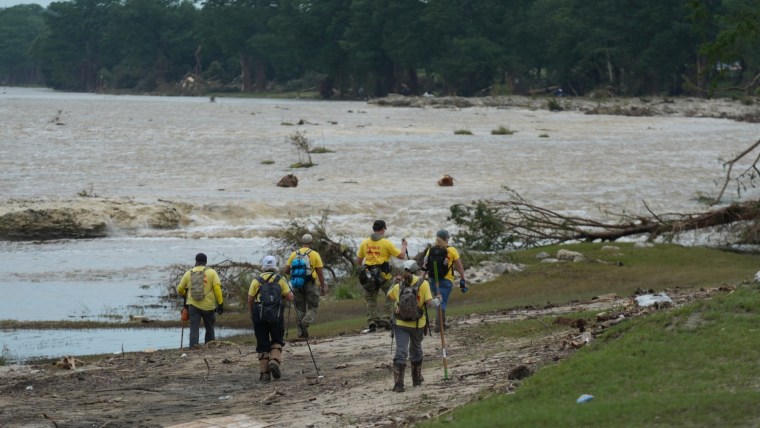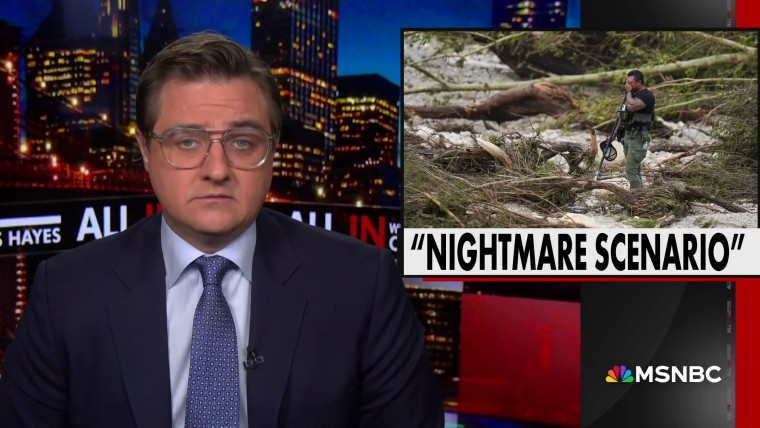This is an adapted excerpt from the July 9 episode of “All In with Chris Hayes.”
I’m sorry, but there are times when a tragedy needs to be “politicized.” Things can go wrong at any time, and disaster can strike anywhere. The whole point of politics and government is to create the conditions that try to shield people from the very worst and take care of the impacted communities afterward as quickly and efficiently as possible.
We can do a good job or a bad job dealing with severe weather. We can plan for it, or not. We can put resources toward those plans, or take resources away from them. In the end, those are all political decisions. So, when a tragedy does strike, we have to ask hard questions about the decisions leading up to and during that moment.
The devastating flash flooding in central Texas last week is a clear-cut example of that. This was a horrible, horrible disaster. The deadliest flooding the state has seen in a century. At least 120 people have died across six counties since the flooding started Friday morning. At least 173 people are still missing.
Could possible failures by their state and federal government have been what made that rushed rescue operation a necessity?
Haunting images have emerged of the devastation at Camp Mystic, a summer camp for girls on the banks of the Guadeloupe River, where at least 27 children and counselors died after they were swept up in the rapidly rising water.
Local first responders have painted a horrifying scene of what it was like trying to rescue residents as the flooding intensified. Civil servants, police officers and volunteers put their bodies on the line trying to get as many people as possible out of harm’s way. They did incredible work. They did all they could.
But could possible failures by their state and federal government have been what made that rushed rescue operation a necessity? Were lives unnecessarily lost because of incompetence or policy decisions or dysfunction? It is not partisan politics to ask those questions. But the administration and its allies disagree.
When House Speaker Mike Johnson was asked if there was anything that could have been done legislatively to help the people of Texas before the floods, the Louisiana Republican told "Fox News Sunday": “In a moment like this, we feel just as helpless as everyone else does. … All we know to do at this moment is pray.”
On Monday, White House press secretary Karoline Leavitt told reporters asking about the response that “blaming President Trump for these floods is a depraved lie, and it serves no purpose during this time of national mourning.”
But no one is blaming Donald Trump “for the floods” — that is an absurd attempt at deflection. They are trying to do the very same thing they have done with the epidemic of gun violence, which is to shout, “How dare you politicize this tragedy?”

Policy is about risk and managing it — and accountability. The government is there to protect us.
Trump knows that because he’s made a cottage industry out of blaming Joe Biden and the Democrats for every natural disaster, from wildfires in Hawaii and California to flooding in North Carolina in the aftermath of Hurricane Helene.
But more and more reporting is calling into question whether lives could have been saved from this flood. We know, for example, that federal forecasters issued warnings to officials in hardest-hit Kerr County three hours and 21 minutes before the first reports of flooding there. But according to The Texas Tribune, “if any local officials got those warnings, and if so, whether they activated in any meaningful way in that 3 hours and 21 minutes remains a black box.”
According to The New York Times, the National Weather Service “employee whose job it was to make sure those warnings got traction — Paul Yura, the long-serving meteorologist in charge of ‘warning coordination’ — had recently taken an unplanned early retirement amid cuts pushed by the so-called Department of Government Efficiency. He was not replaced.”
The Associated Press reported that the Trump administration has cut hundreds of jobs at the National Weather Service, “with staffing down by at least 20% at nearly half of the 122 NWS field offices nationally and at least a half dozen no longer staffed 24 hours a day.” That was a policy change not by our elected representatives in Congress, as the law requires, but by an absentee president and the billionaire he deputized to take a chainsaw to the government.
It didn’t happen in a vacuum. Since May, we have had an acting director for the Federal Emergency Management Agency who “has no background in disaster response and told employees last month that he did not realize the country had a hurricane season,” according to The New York Times, which added that it was not clear if he was joking.
No one is blaming Trump “for the floods” — that is an absurd attempt at deflection.
This is all part of an ongoing, systematic policy to attack the infrastructure of our government. This has shaped Trump’s entire political identity and the people he elevates to positions of power, like an anti-vaxxer who is the head of Health and Human Services, or a head of the Environmental Protection Agency who is rapidly dismantling environmental protections.
This is not by accident. The first time Trump became president, we watched him use a Sharpie to overrule his NOAA forecasters and literally redraw the predicted course of a hurricane. In fact, the acting administrator of the National Oceanic and Atmospheric Administration back then, Neil Jacobs, who put out a statement supporting Trump and rebuking his own climate scientists, is the president’s pick to be NOAA administrator in this administration.
During his Senate confirmation hearing on Wednesday, Jacobs was asked by Democratic Sen. Ben Ray Luján of New Mexico whether he would do anything like that again.
“Let me ask this question because I just had people — constituents die in New Mexico, we had constituents die in Texas,” Luján said. “Would you sign off on an inaccurate statement due to political pressure in the same event, yes or no?”
“No,” Jacobs replied.

